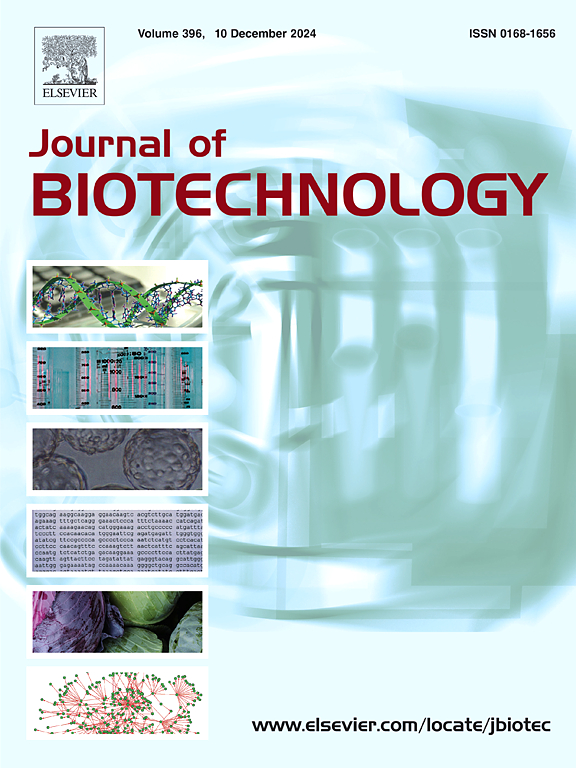Fabrication of a sensitive neurotransmitter detecting amperometric biosensor employing laccase nanoparticles on a pencil graphite electrode
IF 3.9
2区 生物学
Q2 BIOTECHNOLOGY & APPLIED MICROBIOLOGY
引用次数: 0
Abstract
Neurotransmitters including dopamine, adrenaline, and noradrenaline are members of the important class of biogenic amines known as catecholamines. They perform crucial roles in various physiological processes and are frequently associated with stress responses, neurodegenerative and cardiovascular diseases, including Parkinson's and Alzheimer's. This research presents the fabrication of a novel amperometric biosensor designed to detect catecholamine levels with high specificity and sensitivity. The fabrication of the biosensor is based on the immobilization of synthesized cysteine functionalized laccase nanoparticles (Lac-NPs) onto the pencil graphite electrode (PGE). The successful synthesis of Lac-NPs, along with their immobilization and the fabrication of the Lac-NPs/PGE biosensor, was validated through various techniques, including Transmission Electron Microscopy (TEM), Fourier Transform Infrared Spectrophotometer (FTIR), UV–visible Spectroscopy, Dynamic Light Scattering (DLS), Zeta potential, Scanning Electron Microscope (SEM), Cyclic Voltammetry (CV) and Electrochemical Impedance Spectroscopy (EIS). The biosensor was optimized at various pH, temperature, scan rate and response times to ensure a high-performance sensor with rapid response times and stability for better detection. The Lac-NPs/PGE biosensor showed high sensitivity (2320.0 µA/mM cm2), a lower limit of detection (LOD) (0.12 µM), and a broad linear range (0.1–800.0 µM) with a coefficient of determination of R2= 0.999. In the analysis of real pharmaceutical samples of neurotransmitters, high recovery rates (94.0–99.0 %) have been attained. Superior analytical performance resulting from this simple fabrication process and cost-effective PGE shows this biosensor is a promising tool for the accurate and real-time monitoring of catecholamine levels, with potential applications in clinical diagnostics, neurobiology, and environmental analysis.
在铅笔石墨电极上采用漆酶纳米颗粒制备灵敏的神经递质检测安培生物传感器
神经递质包括多巴胺、肾上腺素和去甲肾上腺素是一类重要的生物胺的成员,被称为儿茶酚胺。它们在各种生理过程中发挥着至关重要的作用,经常与应激反应、神经退行性疾病和心血管疾病(包括帕金森病和阿尔茨海默病)有关。本研究提出了一种新型的安培生物传感器,用于检测儿茶酚胺水平,具有高特异性和灵敏度。该生物传感器的制造是基于将合成的半胱氨酸功能化漆酶纳米颗粒(Lac-NPs)固定在铅笔石墨电极(PGE)上。通过透射电子显微镜(TEM)、傅里叶变换红外分光光度计(FTIR)、紫外可见光谱、动态光散射(DLS)、Zeta电位、扫描电子显微镜(SEM)、循环伏安法(CV)和电化学阻抗谱(EIS)等多种技术验证了Lac-NPs的成功合成及其固定化和Lac-NPs/PGE生物传感器的制备。该生物传感器在不同的pH、温度、扫描速率和响应时间下进行了优化,以确保具有快速响应时间和稳定性的高性能传感器,从而更好地进行检测。Lac-NPs/PGE生物传感器灵敏度高(2320.0 µA/mM cm2),检出下限(LOD)为0.12 µM),线性范围宽(0.1 ~ 800.0 µM),决定系数R2= 0.999。在实际药物样品的神经递质分析中,回收率高(94.0 ~ 99.0 %)。这种简单的制造工艺和高性价比的PGE所带来的卓越分析性能表明,这种生物传感器是一种有前途的工具,可以准确实时地监测儿茶酚胺水平,在临床诊断、神经生物学和环境分析方面具有潜在的应用前景。
本文章由计算机程序翻译,如有差异,请以英文原文为准。
求助全文
约1分钟内获得全文
求助全文
来源期刊

Journal of biotechnology
工程技术-生物工程与应用微生物
CiteScore
8.90
自引率
2.40%
发文量
190
审稿时长
45 days
期刊介绍:
The Journal of Biotechnology has an open access mirror journal, the Journal of Biotechnology: X, sharing the same aims and scope, editorial team, submission system and rigorous peer review.
The Journal provides a medium for the rapid publication of both full-length articles and short communications on novel and innovative aspects of biotechnology. The Journal will accept papers ranging from genetic or molecular biological positions to those covering biochemical, chemical or bioprocess engineering aspects as well as computer application of new software concepts, provided that in each case the material is directly relevant to biotechnological systems. Papers presenting information of a multidisciplinary nature that would not be suitable for publication in a journal devoted to a single discipline, are particularly welcome.
 求助内容:
求助内容: 应助结果提醒方式:
应助结果提醒方式:


